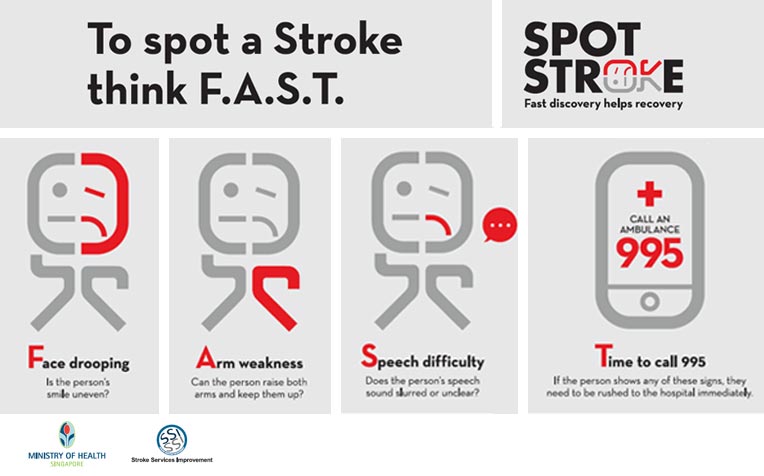HealthXchange will NEVER ask you to transfer money over a call. If in doubt, call the 24/7 ScamShield helpline at 1799, or visit the ScamShield website at www.scamshield.gov.sg.

Stroke symptoms can be spotted if you know how to think F.A.S.T.
Stroke is the leading cause of adult disability and the third most common cause of death worldwide. Yet, many people do not know the symptoms of a stroke.
"Stroke symptoms are caused by damage in the brain due to a blocked blood vessel or bleeding into the brain. A stroke is a medical emergency and it is vital for a person experiencing a stroke to go to the hospital immediately. Early treatment can prevent further brain damage and may improve the chances of a full recovery. A delay in medical treatment may increase the risk of long-term disability and even death," said Assoc Prof Deidre Anne De Silva, Head and Senior Consultant fo the Department of Neurology, National Neuroscience Institute (NNI), a member of the SingHealth group.
Time is of essence in treating a stroke so everyone should learn to recognise the symptoms of a stroke, and respond quickly. Here is a simple way to recognise stroke symptoms. Just remember the word FAST. Each letter stands for a word describing the symptoms of stroke and what to do.
Recognise stroke symptoms by thinking FAST
F - Face: Ask the person to smile. Does one side of the face droop? Does the face or eye look crooked? If so, the person may be having a stroke.
A - Arms: stands for Arms. Ask the person to raise both arms. Does the person have difficulty lifting one or both arms? Do one or both arms drift?
S - Speech: Ask the person to speak or repeat a sentence. Are the words slurred? Is the person having difficulty speaking or is unable to speak? Does the person have a problem understanding you?
T - Time: If all these symptoms – face, arms and speech – are present, the person may be having a stroke. Remember, a stroke is a medical emergency. You must get the person to the hospital immediately.
Call for an ambulance (call 995) and make sure the person reaches the hospital as soon as possible. Note the time the symptoms first started as this information will be important to the doctor and can affect treatment decisions.
Other symptoms of stroke may include:
- Sudden numbness of the face, arm or leg, particularly if one side of the body is affected
- Sudden difficulty seeing with one or both eyes
- Sudden difficulty with walking
- Sudden dizziness, imbalance or uncoordinated movement
So remember: Think FAST for the symptoms of stroke:
F – Face
A – Arms
S – Speech
T – Time
Check out our other articles on stroke:
Stroke: Your Questions Answered
Stroke: 5 Questions to Ask Your Doctor
How to Deal with Potential Complications After a Stroke
Ref: N18
Contributed by
Related Articles
Conditions & Treatments
Public Events
Get the Health Buddy App
© 2025 SingHealth Group. All Rights Reserved.


















 Get it on Google Play
Get it on Google Play